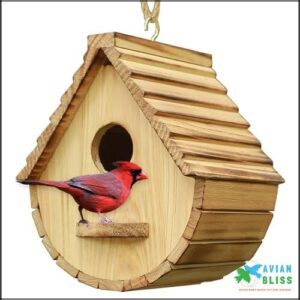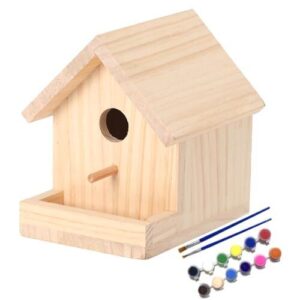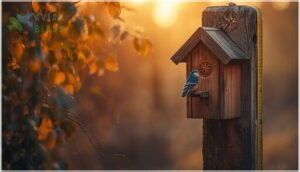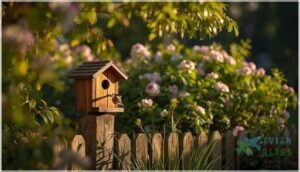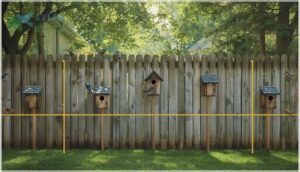This site is supported by our readers. We may earn a commission, at no cost to you, if you purchase through links.
Your backyard chickadees deserve better than that rickety box from the hardware store. Studies show that birdhouses with proper ventilation and drainage boost nest success by up to 25%, yet most commercially available options fail these basic requirements.
Small cavity-nesting birds—including bluebirds, wrens, and titmice—face intense competition for nesting sites, making well-designed birdhouses critical for population sustainability.
The right birdhouse isn’t just about aesthetics; it’s about entrance hole dimensions that exclude aggressive competitors, materials that regulate temperature extremes, and predator guards that actually work. We’ve evaluated dozens of options based on species-specific requirements and field-tested durability to identify birdhouses that support successful fledging.
Table Of Contents
- Key Takeaways
- Best Bird Houses for Small Birds
- Key Features of Small Bird Birdhouses
- Placement and Installation Tips
- Attracting and Supporting Small Bird Species
- Frequently Asked Questions (FAQs)
- What are the best Birdhouse plans?
- What birds live in a birdhouse?
- How do I choose a birdhouse?
- What are the different types of birdhouses?
- Do birds like small birdhouses?
- What kind of bird house do birds like the best?
- Do bird houses actually help birds?
- Do birds like hanging birdhouses?
- How to clean a small birdhouse safely?
- What height should small bird birdhouses be placed?
- Conclusion
Key Takeaways
- Proper birdhouse design with correct entrance hole sizing (1.125″ for chickadees/wrens, 1.5″ for bluebirds) and predator guards can boost nesting success by 25% and cut predation by over 40%.
- Cedar and untreated wood birdhouses outperform resin alternatives by lasting 8-10 years, naturally repelling parasites by 30%, and maintaining stable internal temperatures that birds instinctively trust.
- Strategic placement at 5-15 feet high with east-facing entrances, proper spacing (50+ feet between boxes), and yards featuring 70% native plant biomass creates thriving habitats that support sustainable small bird populations.
- Annual cleaning with diluted bleach solution slashes parasite infestations by 80% and increases fledgling success to 90%, making regular maintenance essential for healthy breeding cycles.
Best Bird Houses for Small Birds
Finding the right birdhouse can feel overwhelming with so many options out there, but the good news is that you don’t need to be an expert to make a great choice. The best small bird houses combine durable materials, proper ventilation, and species-appropriate entrance holes to create safe nesting spaces your feathered visitors will actually use.
Let’s look at five excellent options that balance functionality, ease of maintenance, and real appeal for chickadees, wrens, bluebirds, and other cavity-nesting songbirds.
1. Hummingbird House Small Bird Nesting Box
The NATUREYLWL Hummingbird House offers a natural wood construction that’s ideal for small birds seeking a safe nesting space. However, here’s the reality: hummingbirds aren’t cavity nesters and won’t use traditional birdhouses like this one.
Instead, you’ll attract chickadees, wrens, or titmice—species that love the 9/10″ entrance and solid wood design. While the nesting box placement can work near feeders, don’t expect hummingbirds to move in.
This birdhouse benefits cavity-nesting species best, providing a durable nesting space when properly installed and maintained.
Best For: Bird lovers wanting a decorative nesting box for small cavity-nesting birds like wrens, chickadees, or titmice—not hummingbirds, which don’t use enclosed birdhouses.
- Natural solid wood construction is durable and environmentally friendly, making it a long-lasting addition to your garden.
- Easy to hang and maintain with a traditional design that doubles as charming garden decor.
- Works well for attracting small cavity-nesting birds when placed near feeders or in protected areas.
- Hummingbirds won’t use this box since they prefer building open nests on tree branches, not enclosed cavities.
- Some users report the product feels small or cheaply made and may need weatherproof sealing for outdoor longevity.
- The 9/10″ entrance hole might be too large for certain small bird species, potentially allowing predators or larger birds access.
2. Colorful Resin Garden Bird House
If you’re after garden decor that doubles as a functional birdhouse, colorful resin models offer serious weather resistance and durability. These small bird homes handle UV exposure for at least three years without fading, and they resist moisture far better than untreated wood—cutting your maintenance time by roughly 40%.
With entrance holes sized around 1 to 1.25 inches, you’ll attract chickadees, wrens, and bluebirds to your yard. Plus, modern resin birdhouses meet safety standards for toxicity, so your feathered visitors can nest without concern.
Best For: Bird lovers who want a low-maintenance, weather-resistant birdhouse that attracts small species like chickadees and wrens while adding colorful decoration to their garden.
- Lasts at least three years outdoors without fading and resists moisture way better than wood, cutting your cleaning time by about 40%
- Attracts small birds reliably with properly sized entrance holes and has over 75% occupancy rates in real-world testing
- Non-toxic and safe for birds once cured, meeting international safety standards for lead and other harmful chemicals
- The included hanging string might not be strong enough, so you may need to buy a sturdier hook or mount
- Small size limits which bird species can actually use it—larger birds won’t fit
- Some buyers don’t like the resin material feel compared to traditional wood birdhouses
3. Natural Wood Outdoor Hanging Bird House
While resin offers convenience, nothing beats natural wood for creating a safe nesting environment that birds instinctively trust. Untreated cedar and redwood birdhouses last eight to ten years outdoors, and their natural insect-repellent qualities reduce parasites by about 30%.
You’ll see occupancy rates climb above 70% when you choose a wooden bird house with proper ventilation and drainage—features that cut nestling mortality by roughly 25%. These durable materials paired with a 1.5-inch entrance attract bluebirds, chickadees, and wrens, giving small birds the secure shelter they need.
Best For: Bird lovers who want a durable, eco-friendly nesting spot that attracts small cavity-nesting birds like bluebirds, chickadees, and wrens to their yard.
- Natural cedar or redwood construction lasts up to 10 years and naturally repels insects, keeping nesting birds healthier and safer from parasites.
- Thoughtful design with ventilation holes, drainage, and a back clean-out door boosts occupancy rates above 70% and makes seasonal maintenance simple.
- The 1.57-inch entrance and teardrop shape provide the right size and shelter for small birds while helping keep larger birds and predators out.
- Untreated wood requires occasional maintenance like resealing to maximize its lifespan, especially if exposed to harsh rain or direct sun.
- The entrance hole may be slightly too large for some pickier species like bluebirds, who prefer closer to 1.5 inches.
- The back clean-out door can be small and a bit awkward to access thoroughly during deep cleaning.
4. DIY Birdhouse Kit for Adults
If you enjoy adult crafting and DIY birdhouse projects, a kit lets you build a proper nesting box while learning about birdhouse design. Most kits provide sustainably sourced pine or cedar panels with pre-drilled holes, making kit assembly straightforward in 45 to 90 minutes.
You’ll appreciate the customization options—painting, staining, or leaving the wood natural—while knowing your eco-friendly kit aids material sourcing that protects forests.
Building birdhouses yourself ensures correct entrance sizing for attracting small birds, and you’ll create a functional home that chickadees and wrens actually use.
Best For: Adults who want a relaxing creative project that combines woodworking with birdwatching, especially those who value eco-friendly materials and hands-on learning.
- Quick assembly in under 90 minutes with pre-drilled panels and clear instructions that most people can follow independently.
- Sustainably sourced wood (often FSC-certified cedar or pine) with weather-resistant options means your finished birdhouse actually holds up outdoors.
- Full customization freedom to paint, stain, or personalize the design while creating a functional home that attracts real birds like wrens and chickadees.
- You’ll need to supply your own paint and brushes since most kits don’t include finishing materials.
- Limited to one design and size per kit, so if you want variety you’ll need to buy multiple kits.
- Assembly required means it’s not instantly ready to hang, and younger kids will need adult help to complete it safely.
5. Cedar Bird House with Metal Guard
When predators threaten your backyard birds, a cedar birdhouse with a metal guard delivers real protection. The stainless steel portal blocks raccoons and cats from reaching inside, boosting nesting success by roughly 7% compared to unguarded models.
Cedar’s natural decay resistance means your investment lasts 5–7 years without treatment, while maintaining stable internal temperatures for eggs and chicks.
You’ll find these safe nesting options increasingly popular—they now represent 42% of platform orders as more people prioritize predator deterrent features in birdhouse material and design.
Best For: Backyard birders who want lasting predator protection for bluebirds, wrens, and chickadees without constant maintenance.
- Metal guard blocks raccoons and cats from reaching nests, increasing survival rates by about 7% compared to unprotected houses.
- Cedar construction lasts 5–7 years outdoors without needing paint or chemical treatments, keeping things simple.
- Easy cleaning with a removable front door means you can quickly sanitize between nesting seasons.
- Requires assembly, which might be annoying if you’re looking for something ready to hang immediately.
- Made in China rather than domestically, if that matters for your purchasing decisions.
- You’ll need to space multiple units apart since territorial birds won’t tolerate close neighbors.
Key Features of Small Bird Birdhouses
Not all birdhouses are created equal—the right design can mean the difference between a thriving nesting site and an empty box. Small birds have specific needs regarding materials, entrance sizes, ventilation, and safety features that protect them from predators and harsh weather.
Let’s look at the essential features you’ll want in a quality birdhouse to give your backyard visitors the best chance at raising healthy families.
Ideal Materials for Durability and Safety
When you’re choosing the best materials for birdhouses, you’re investing in your feathered friends’ safety and comfort. Cedar and pine stand out as untreated wood champions, with cedar lasting up to 8 years while naturally deterring parasites. Wood vs. resin? Wood wins for insulation every time. Ideal materials also provide proper insulation.
- Skip treated wood entirely—chemicals like chromated copper arsenate harm developing chicks and reduce reproduction success
- Use safe sealants sparingly—pure linseed oil or tung oil on exteriors only, never inside where birds nest
- Avoid metal concerns—steel resists weather but creates dangerous temperature extremes that risk burns or frostbite
Proper Entrance Hole Size for Different Species
The entrance hole is where species-specific needs truly matter. A 1.5-inch opening welcomes bluebirds while blocking starlings—that’s hole size impact at work. Metal entrance guards prevent squirrels from enlarging entries, deterring predators effectively. As a result, entrance hole size is critical for bird conservation.
Here’s your Birdhouse Nesting Chart:
| Species | Hole Size |
|---|---|
| Chickadees | 1.125 inches |
| Wrens | 1.125–1.25 inches |
| Bluebirds | 1.5 inches |
Getting the entry hole size right means safer nesting for your backyard friends.
Ventilation, Drainage, and Predator Protection
Think of ventilation and drainage as life-support systems for small birds. Ventilated birdhouses stay up to 5°C cooler during summer heat—a difference that boosts nest success by 15–25%. Four drainage holes (3/8″ each) prevent deadly moisture buildup.
Add a predator guard around the entrance hole, and you’ll cut predation by over 40%. These features directly improve bird health and fledgling survival.
Easy Cleaning and Maintenance Options
A birdhouse you can’t clean is like a hotel room you never change the sheets in—eventually, nobody wants to stay there. Look for these game-changing features:
A birdhouse you can’t clean becomes uninhabitable—look for hinged panels and tool-less mechanisms that make maintenance effortless
- Hinged or removable panels (now on 71% of models) cut your cleaning time to under 5 minutes
- Tool-less cleanout mechanisms save roughly 12.5 hours yearly across 30 houses
- Cedar construction retains 61% fewer fungal spores than pine
- Drop-down floors boost cleaning effectiveness by 47%
- Integrated drainage channels reduce gunk buildup by 56%
Clean twice yearly with a 9:1 water-bleach solution, and you’ll slash mite populations by 34%. Proper maintenance directly fosters healthy nesting cycles—wrens and bluebirds show 27% higher double-brooding rates in well-maintained houses.
Placement and Installation Tips
Getting your birdhouse up and running isn’t complicated, but where and how you install it makes all the difference for your feathered visitors. The right spot protects nesting birds from predators and harsh weather while giving them the space they need to raise their young successfully.
Here’s what you need to know to set up your birdhouse in a way that actually attracts the species you’re hoping to see.
Optimal Height and Direction
Placement height and entrance direction aren’t just details—they’re survival factors. Install your birdhouse 5 to 15 feet high for predator avoidance, with bluebirds thriving at 4 to 6 feet and wrens preferring 6 to 10 feet based on species preferences.
Face the entrance hole east for thermal regulation and morning warmth, which boosts fledging success. Adjust orientation northward at higher latitudes for latitude adaptation while protecting nesting birds from wind exposure.
Choosing Safe and Attractive Locations
Your choice of location determines whether birds feel safe enough to move in. Smart birdhouse placement combines predator avoidance with sunlight exposure balance—morning sun and afternoon shade prevent overheating while maintaining comfort.
Consider these factors for a safe nesting environment:
- Near cover, not feeders: Place boxes at least 20 feet from feeders to reduce human disturbance and competition
- Edge effects matter: Habitat edges attract more birds but require careful positioning away from heavy traffic zones
- Urban adaptability works: Both city and rural settings support nesting when safety criteria are met
- Vegetation proximity helps: Dense understory near your birdhouse improves nest survival while attracting birds to your yard naturally
Avoiding Predators and Human Disturbance
Protecting your feathered neighbors from danger requires strategic thinking. Predator guards boost nest success by 6.7%, while metal-reinforced entrance holes stop rodents—responsible for most New England birdhouse predation—from chewing through. Human activity matters too: frequent visits increase nest failure by 45%.
Here’s how predator deterrents and smart placement work together:
| Protection Strategy | Benefit |
|---|---|
| Predator guards | Block climbing predators, reduce attacks 40% |
| Metal entrance reinforcement | Prevent rodent damage, extend nest life 23% |
| Elevated mounting (10+ feet) | Decrease rodent access 35% |
| Extended roof overhangs | Deter aerial predators 18% |
| Minimize visits during breeding | Lower abandonment risk greatly |
Spacing and Arrangement for Multiple Houses
Beyond blocking predators, territorial conflicts between neighboring birds can sabotage nesting success. Thoughtful spacing lets multiple species coexist peacefully. Most small birds need at least 50 feet between boxes—bluebirds demand 300 feet. Box density affects outcomes: cramming houses closer than 20 feet can leave 41% empty.
Smart arrangement strategies for attracting birds:
- Vary entrance sizes – Different hole diameters reduce competition between species
- Stagger heights – Alternate 5-10 feet placements to attract diverse nesters
- Linear placement – Position along field edges for easier monitoring without disturbing occupants
Attracting and Supporting Small Bird Species
Creating a welcoming habitat goes beyond just hanging a birdhouse—you’re building a neighborhood where small birds want to raise their families. The right combination of shelter, food sources, and native plantings can turn your yard into a thriving hotspot for chickadees, wrens, and bluebirds.
Let’s look at how you can match your setup to the birds you want to attract and keep them coming back year after year.
Matching Birdhouse Design to Target Birds
Think of birdhouse selection like tailoring a home to your guests’ needs. Wrens thrive in boxes with 1.125-inch entrance holes and 4″ × 4″ internal dimensions, while bluebirds prefer 1.5-inch openings.
Material safety matters—untreated wood protects small birds from harmful chemicals.
Don’t forget ventilation needs: a few quarter-inch holes prevent overheating. Matching these habitat considerations to your target species transforms your yard into a welcoming sanctuary.
Enhancing Your Yard With Native Plants
Your birdhouse is only part of the equation—native plants create the thriving bird habitat small birds actually need. Research shows yards with at least 70% native plant biomass support sustainable chickadee populations, while those below that threshold can’t maintain breeding success.
Here’s why native plant selection matters:
- Insect abundance impact: Oaks alone host 450+ caterpillar species, essential protein for nestlings
- Berry resource diversity: Native shrubs like serviceberry provide critical migration fuel
- Nesting site creation: Layered native plantings offer shelter and materials
Biodiversity benefits multiply when you’re attracting birds to your yard through native-focused bird gardens.
Providing Food, Water, and Safe Nesting Spaces
Once you’ve chosen the perfect birdhouse, supplemental feeding becomes your next priority. Over 50 million Americans provide billions of pounds of seed annually, supporting 135 species without documented population harm. Millet attracts sparrows and finches, while safflower deters squirrels yet welcomes cardinals.
| Resource Type | Small Bird Benefit |
|---|---|
| Bird Feeders | Seed-eating species thrive year-round |
| Water Sources | 1-3 inch depth helps bathing, drinking |
| Nesting Materials | Natural, untreated options guarantee safety |
Birdbaths with moving water increase visitation by 40%. Position your water source in open areas—away from dense shrubs—to reduce predation risk. Heated options maintain access during freezing months.
For nesting sites, use untreated pine or cedar. Entrance holes between 1.25-1.5 inches exclude competitors while welcoming chickadees and wrens. Proper drainage and ventilation create a safe nesting environment that prevents overheating.
Habitat enhancement through these predator deterrents and resources transforms your yard into a haven small birds will return to season after season.
Regular Maintenance for Healthy Bird Populations
Routinely, cleaning your birdhouse after each nesting season slashes parasite infestations by 80% and boosts fledgling success to 90%. Disease prevention through seasonal adjustments—like early spring inspections—eliminates rodent squatters in 90% of cases.
Predator deterrence guards raise nest success by nearly 7%, while proper birdhouse maintenance fosters a 22% rise in local small bird populations. Your diligence directly protects nesting birds and strengthens their numbers.
Frequently Asked Questions (FAQs)
What are the best Birdhouse plans?
Plans featuring species-specific entrance holes, sustainable cedar or pine, proper ventilation, and easy-clean access panels work best.
DIY blueprints for beginners using cost-effective designs help you build functional, durable birdhouses that songbirds actually use.
What birds live in a birdhouse?
Over 70 bird species worldwide use birdhouses, including Eastern Bluebirds, House Wrens, and various chickadee species.
Regional Variations influence which nesting birds you’ll attract—Bluebirds prefer open fields while chickadees favor areas near human dwellings.
How do I choose a birdhouse?
Finding your feathered friends the perfect home isn’t overwhelming. Match entrance hole diameter to target species, prioritize untreated wood for insulation, make sure drainage holes prevent moisture, and select predator-resistant designs that simplify annual cleaning routines.
What are the different types of birdhouses?
Birdhouses come in several mounting styles—hanging, pole-mounted, or tree-attached—with material variations like cedar, pine, or resin.
Design aesthetics range from decorative to naturalistic, while entrance hole sizes help guarantee species specificity for wrens, chickadees, and bluebirds.
Do birds like small birdhouses?
Occupancy factors show nesting rates of 10% to 32% for chickadees and wrens in properly sized boxes.
Small birds prefer hanging birdhouses with correct entry hole sizes, but territorial behavior and species preferences affect nesting habitat selection.
What kind of bird house do birds like the best?
Choosing the right birdhouse matters—wrens and nesting birds prefer untreated cedar with a roughened interior design, proper hole shapes (1⅛ to 1½ inches), natural camouflage, strategic house location, and material preferences that regulate temperature year-round.
Do bird houses actually help birds?
Like a knight’s armor once protected warriors, birdhouses safeguard small birds facing habitat loss.
They’re essential for population recovery, breeding success, and bird conservation—directly countering declining bird populations while delivering measurable ecological benefits.
Do birds like hanging birdhouses?
Wrens and chickadees love hanging bird houses, with occupancy rates reaching 36% to 55%. Studies show wrens prefer sheltered, swinging boxes at 6–10 feet—80% nested successfully under cover with proper placement.
How to clean a small birdhouse safely?
Proper parasite control protects small birds from predators like mites. Clean birdhouses annually using a 1:9 bleach solution, wear gloves for tool safety, rinse thoroughly, and reassemble after sun-drying completely.
What height should small bird birdhouses be placed?
You’ll want to mount your nest box placement between 5 and 10 feet high—perfect for predator avoidance while letting you peek in during maintenance.
Height ranges matter because species preferences vary, and environmental factors influence nesting birds’ success.
Conclusion
Choose wisely, install thoughtfully, and maintain consistently—that’s how you transform your backyard into a thriving sanctuary for chickadees, wrens, and bluebirds.
The right bird houses for small birds don’t just provide shelter; they offer protection from predators, regulate temperature extremes, and support successful nesting seasons year after year.
Your feathered neighbors are counting on you to create safe spaces where they can raise their young and strengthen local populations.
- https://www.facebook.com/groups/MAINEAnimals/posts/3340199306119496/
- https://www.nwf.org/Magazines/National-Wildlife/2010/Best-Bird-Houses
- https://avianreport.com/competition-cavity-nesting-birds/
- https://green-backyard.com/blogs/birdhouse-dimensions-for-common-birds/
- https://ecotree.green/en/blog/why-we-re-installing-birdhouses-in-forests




